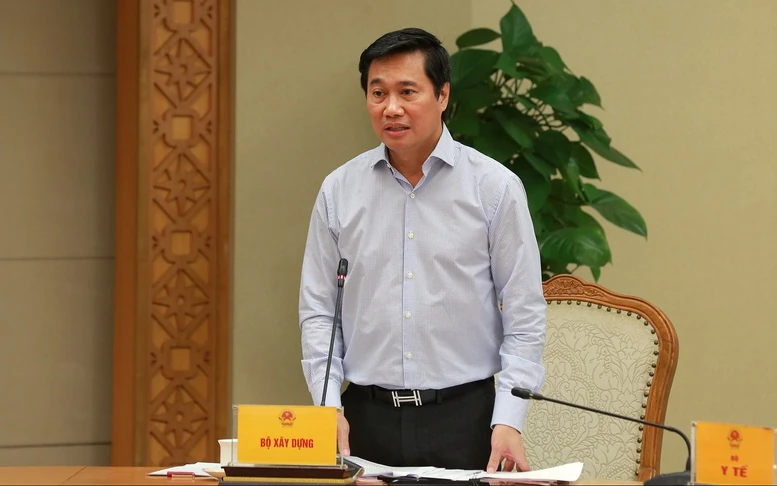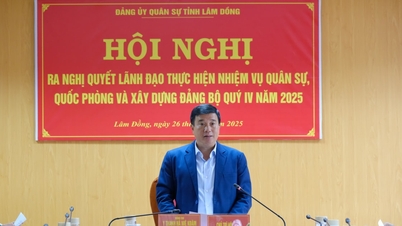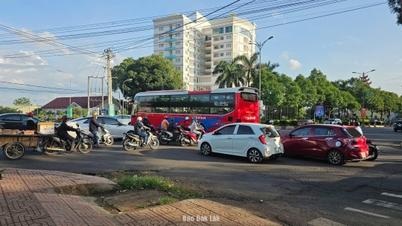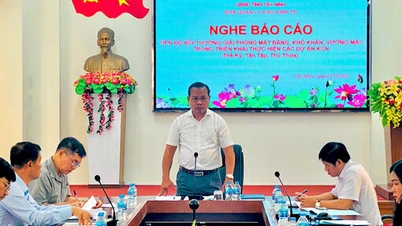Deputy Prime Minister Tran Hong Ha chaired a meeting to give comments on the Draft Law on Urban and Rural Planning (amended); the Draft Resolution of the National Assembly Standing Committee on urban classification and guiding documents - Photo: VGP/Minh Khoi
Planning must be associated with urban management and infrastructure development.
According to the Deputy Prime Minister , the current Planning Law regulates most types of planning: National, regional, provincial, and sectoral planning. However, in parallel, there still exists the Law on Urban and Rural Planning and the Construction Law, which regulate many contents related to urban and rural planning.
As a result, in the same territorial space, a province, a commune, a ward... there are many coexisting plans: Land use planning, construction planning, urban-rural planning, zoning planning... The situation of "one area, many plans" makes the management and allocation of land resources, human resources, resources... become complicated and unfeasible.
In addition, according to the law, planning must be made in the correct order: from general planning to zoning planning, then detailed planning. However, in reality, many places only have general planning, and then many years later, zoning is established, making detailed planning unfounded. This "reverse process" situation causes congestion and even conflicts when implementing projects.
“Planning should be a scientific tool for allocating and using resources, but currently there are overlaps and contradictions, leading to problems for thousands of projects across the country,” the Deputy Prime Minister pointed out.
Regarding the Draft Law, the Deputy Prime Minister proposed two approaches to amending it. One is to develop urban and rural planning as a complete spatial planning type, which can replace some other planning (such as land use planning, provincial planning, city planning). This planning must include general planning, zoning planning, and detailed planning for urban areas, provinces, and cities.
Second is to integrate urban and rural planning into higher-level planning (provincial planning, national master planning). Then, the general planning of provinces and centrally-run cities will play the main planning role, limiting the situation of making many parallel plans.
The Deputy Prime Minister also noted that urban planning cannot be separated from urban management and technical infrastructure, especially water supply and drainage. "A city without infrastructure cannot be considered a true city. Planning must be linked to management work, as a tool for development management," he emphasized.
Believing that it is necessary to reconsider maintaining two legal systems, one on general planning and one on urban and rural planning, the Deputy Prime Minister raised the issue: If urban and rural planning have their own characteristics, they can be integrated into a chapter in the Planning Law, instead of leaving them in parallel, causing conflicts.
Regarding the content of criteria for urban classification, the Deputy Prime Minister requested the drafting agency (Ministry of Construction) and delegates to analyze and clarify the practical and scientific basis for legalizing it into a resolution of the National Assembly Standing Committee. "Criteria for urban classification need to be thoroughly researched scientifically, put directly into law, and become a legal and scientific basis for planning work," the Deputy Prime Minister suggested.
“This amendment must be determined to change thinking and thoroughly overcome the shortcomings of the urban and rural planning system,” the Deputy Prime Minister concluded.
Shorten the process, streamline planning tasks
Deputy Minister of Construction Nguyen Tuong Van reports at the meeting - Photo: VGP/Minh Khoi
Reporting at the meeting, Deputy Minister of Construction Nguyen Tuong Van said the main goals of this revision are to perfect the urban and rural planning system and clarify the relationship with the national planning system and sectoral planning.
In line with the two-level government model, clearly defining the scope and subjects of planning instead of the old approach which is based on administrative units (cities, towns, townships).
Clarify planning levels, shorten the process from general planning to management, avoid formalities, and ensure feasibility in project implementation.
Synchronize planning types, ensure uniformity in boundaries between urban areas, economic zones, national tourist areas and other functional areas; at the same time, strengthen decentralization, clarify responsibilities of each level of government and simplify administrative procedures.
The planning process can be shortened. Previously, from general planning, it had to go through zoning planning, then detailed planning; now with digital technology and complete, integrated data, there are only two levels: General planning (including zoning content) and detailed planning associated with the project.
Planning tasks are also streamlined, unnecessary procedures are removed, only requirements are kept as "headings" for consulting research. This is to reduce delays and shorten project implementation time.
An important new point is stronger but flexible decentralization. Commune level can independently approve planning when it has enough capacity; in remote areas where it is not guaranteed, the provincial level will directly support and decide.
Deputy Minister Nguyen Tuong Van affirmed that urban and rural planning includes full technical, economic and social criteria and construction standards. For example, each urban area, when classified by level, has specific regulations on green space, traffic infrastructure and social infrastructure. Therefore, this type of planning can replace many other plans, including land use plans.
“This is a technical and scientific tool, closely linked to space allocation and the determination of specific projects and works; not just general growth indicators,” Deputy Minister Nguyen Tuong Van emphasized.
Proposing criteria for urban classification suitable for the new situation
Regarding the Draft Resolution on urban classification, the Ministry of Construction said that the goal is to evaluate the quality of planning, infrastructure and the level of urban development; associated with the need to consider converting from commune to ward or province to city directly under the Central Government.
The classification system gathers many criteria and standards, which are both products and inputs for planning work. On that basis, the Ministry proposes 3 main groups of criteria to evaluate urban classification: Role, location and function (political, administrative, economic, cultural - social, general or specialized center); Level of urbanization (population size, non-agricultural labor rate, urban - rural population ratio); Level of infrastructure development and landscape architecture space (technical infrastructure, social infrastructure, development management organization).
Based on 3 groups of criteria, the urban system of the whole country will be divided into 4 basic groups: National central urban areas (cities directly under the Central Government, with the highest level of development, playing a leading role, even reaching the regional level); Regional central urban areas (related to inter-provincial and regional roles); Provincial central urban areas; Lower-level urban areas, associated with communes and wards.
The criteria also provide guidance for local authorities to compare and determine what is available and what is lacking, thereby establishing investment programs and plans according to the roadmap.
Notably, with the absence of separate urban governments (provincial cities, towns, townships, etc.), the Ministry of Construction proposed new criteria to determine the scope and boundaries of urban areas, based on population size and area, linked to a system of technical standards and regulations, being a place with a high population density, a high proportion of non-agricultural labor, and adequate technical and social infrastructure.
The Deputy Prime Minister emphasized that the content of urban classification criteria needs to be approached in a comprehensive, synchronous and clearly oriented manner, "must go ahead and become the basis for building urban-rural planning, instead of just relying on available planning. "This criterion is the input, leading the process of drawing up a picture of urban development, in the current context where we are facing many difficulties in terms of basis and method," said the Deputy Prime Minister.
Delegates speak at the meeting - Photo: VGP/Minh Khoi
At the meeting, Mr. Tran Ngoc Chinh, Chairman of the Vietnam Urban Development Planning Association, emphasized that the amendment of the Law on Urban and Rural Planning is an urgent requirement, of great significance to national development. The law must be designed in a modern manner, in line with domestic requirements, international integration and in sync with the national master plans being adjusted; adapt to the 2-level government model; thoroughly researched to preserve the brand value, history and culture of many familiar cities such as Hoi An, Da Lat, Vinh...
Dr. Ngo Trung Hai, General Secretary of the Association of Vietnamese Cities, said that the process of amending the Law on Urban and Rural Planning needs to remove shortcomings, give initiative to the grassroots level but not distort the urban spatial structure that has been formed and developed according to natural and historical laws. If local planning at the commune/ward level is left to lead, practical conflicts may arise such as lack of land for cemeteries, landfills, wastewater treatment... causing difficulties in management and coordination.
Citing international experience, Dr. Ngo Trung Hai proposed establishing an urban management board established by the province, or an inter-ward or inter-commune council, to coordinate planning on a common space scale, avoiding fragmentation and locality.
Representative of Vietnam Association of Architects speaking at the meeting - Photo: VGP/Minh Khoi
Meanwhile, Dr. Luu Duc Hai, Director of the Institute for Urban Research and Infrastructure Development (Vietnam Construction Association) said that the fundamental solution is to assign the provincial government to manage, inherit and continue to orient the development of previously planned urban areas, to gradually re-urbanize within the current administrative units.
Besides, urban is not a sector, but a place that fully integrates economic, social, technical infrastructure and social infrastructure factors. Therefore, urban planning needs to be overall spatial while sectoral planning needs to be directional.
Hai Phong City leaders speak at the meeting - Photo: VGP/Minh Khoi
Agreeing with this opinion, leaders of the People's Committees of Hanoi and Hai Phong City suggested that it is necessary to view urban and rural planning as inter-sectoral spatial planning for development, avoiding being generalized into sectoral planning; supplementing management mechanisms and tools suitable to the reality of large cities after mergers and rearrangements.
Leaders of the Ministry of Culture, Sports and Tourism, the Ministry of Information and Communications, and the Ministry of Health agreed that this law amendment must be carefully studied, with a long-term orientation, and address two parallel directions: Developing rural areas into urban areas, and preserving and developing existing urban areas even though they no longer have an administrative role.
The law needs to be synchronized with other resolutions and plans and create a legal corridor to develop green, smart, sustainable urban areas, preserve cultural and historical values and meet people's living needs.
Deputy Minister of Culture, Sports and Tourism Hoang Dao Cuong suggested that there should be a separate mechanism for urban areas with cultural, historical or heritage values such as Hue, Ha Long, Da Lat, Sa Pa...
Legal foundation for management and development of urban-rural systems
The Deputy Prime Minister stated that the amended Law must both preserve existing achievements and legacies and eliminate old shortcomings, to open a period of modern, sustainable urban-rural development suitable to the new context - Photo: VGP/Minh Khoi
Concluding the meeting, Deputy Prime Minister Tran Hong Ha pointed out that in recent times, the process of law-making in the field of urban and rural planning has had many limitations, from inconsistent awareness, fragmented thinking to loose methodology. That has led to an overlapping, contradictory, and uncomprehensive legal system, hindering development.
Meanwhile, the Law on Urban and Rural Planning is the legal foundation for the management and development of the urban-rural system in the coming decades, directly related to national development, and needs to be built fundamentally and synchronously to thoroughly overcome current shortcomings.
From this reality, the amendment must aim at three major goals. First, the law must ensure consistency and unity with the two-level government system, linked with decentralization, delegation of power and thoroughly handle long-standing shortcomings. Second, the law needs to inherit the achievements that have been made, which are hundreds of urban areas that have been formed, many regional plans and socio-economic development strategies that are still effective, cannot be denied or abolished, but must be reviewed and adjusted accordingly. And finally, the law must orientate modern development, build a master plan for the urban-rural network nationwide, and classify urban areas based on scientific criteria, have forecasting properties and accurately reflect the quality of life.
The Deputy Prime Minister emphasized that the key is to clearly define the nature of urban and rural planning as national planning or sectoral planning, the scientific basis and legal status. The classification of special urban areas, urban areas of type I, II, III, IV cannot be based solely on population size or construction density but requires a set of criteria reflecting the depth of quality, from cultural and architectural identity, climate change adaptation, smart urban areas, digital transformation, to traffic planning, underground space, medical, educational, cultural and sports institutions. The amended law must also clearly define development models such as compact urban areas, ecological urban areas, smart urban areas, urban areas with traffic routes (TOD), satellite urban areas... to ensure long-term orientation.
The Deputy Prime Minister is particularly interested in the content of rural planning, because "in a centrally-run city there are still rural areas, so urban planning cannot be separated from rural areas".
The law must clarify density, economic structure, agricultural land, environment, infrastructure and rural architectural identity, and have appropriate designs for each region. This is not only a condition for sustainable development but also creates land funds for future urbanization.
From the issues raised, the Deputy Prime Minister requested the Ministry of Construction to establish a working group consisting of experts, relevant ministries and branches to work with the Ministry to review and redefine the theoretical basis, practice, scope, subjects, structure and content of the law, report to the Government and make recommendations to the National Assembly.
The Deputy Prime Minister stated that the amended Law must both preserve existing achievements and legacies and eliminate old shortcomings, to open a new stage of modern, sustainable urban-rural development, suitable for the new context. Major, principled issues must be legalized, while technical and detailed issues will be assigned to the Government to regulate. The set of criteria for urban classification needs to be clearly developed and can be included in resolutions of the National Assembly or the National Assembly Standing Committee for approval to create a basis for immediate implementation.
According to Chinhphu.vn
Source: https://baothanhhoa.vn/sua-doi-luat-quy-hoach-do-thi-va-nong-thon-dong-bo-khac-phuc-bat-cap-ke-thua-thanh-qua-260997.htm









![[Photo] President of the Cuban National Assembly visits President Ho Chi Minh's Mausoleum](https://vphoto.vietnam.vn/thumb/1200x675/vietnam/resource/IMAGE/2025/10/1/39f1142310fc4dae9e3de4fcc9ac2ed0)

![[Photo] Hanoi morning of October 1: Prolonged flooding, people wade to work](https://vphoto.vietnam.vn/thumb/1200x675/vietnam/resource/IMAGE/2025/10/1/189be28938e3493fa26b2938efa2059e)

![[Photo] Keep your warehouse safe in all situations](https://vphoto.vietnam.vn/thumb/1200x675/vietnam/resource/IMAGE/2025/10/1/3eb4eceafe68497989865e7faa4e4d0e)
































































































Comment (0)